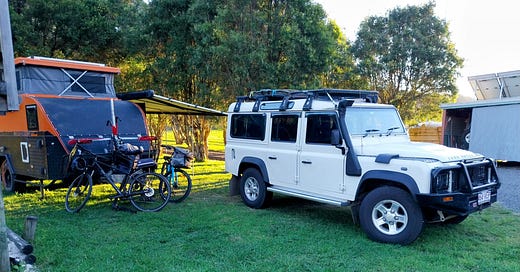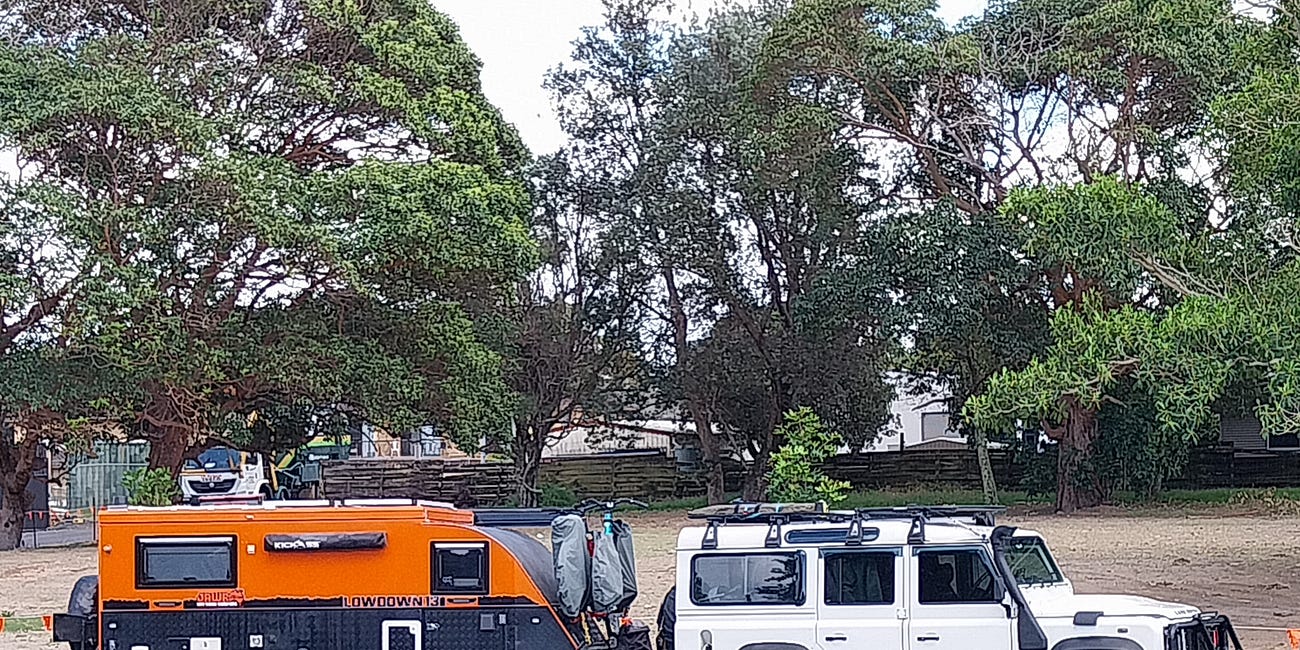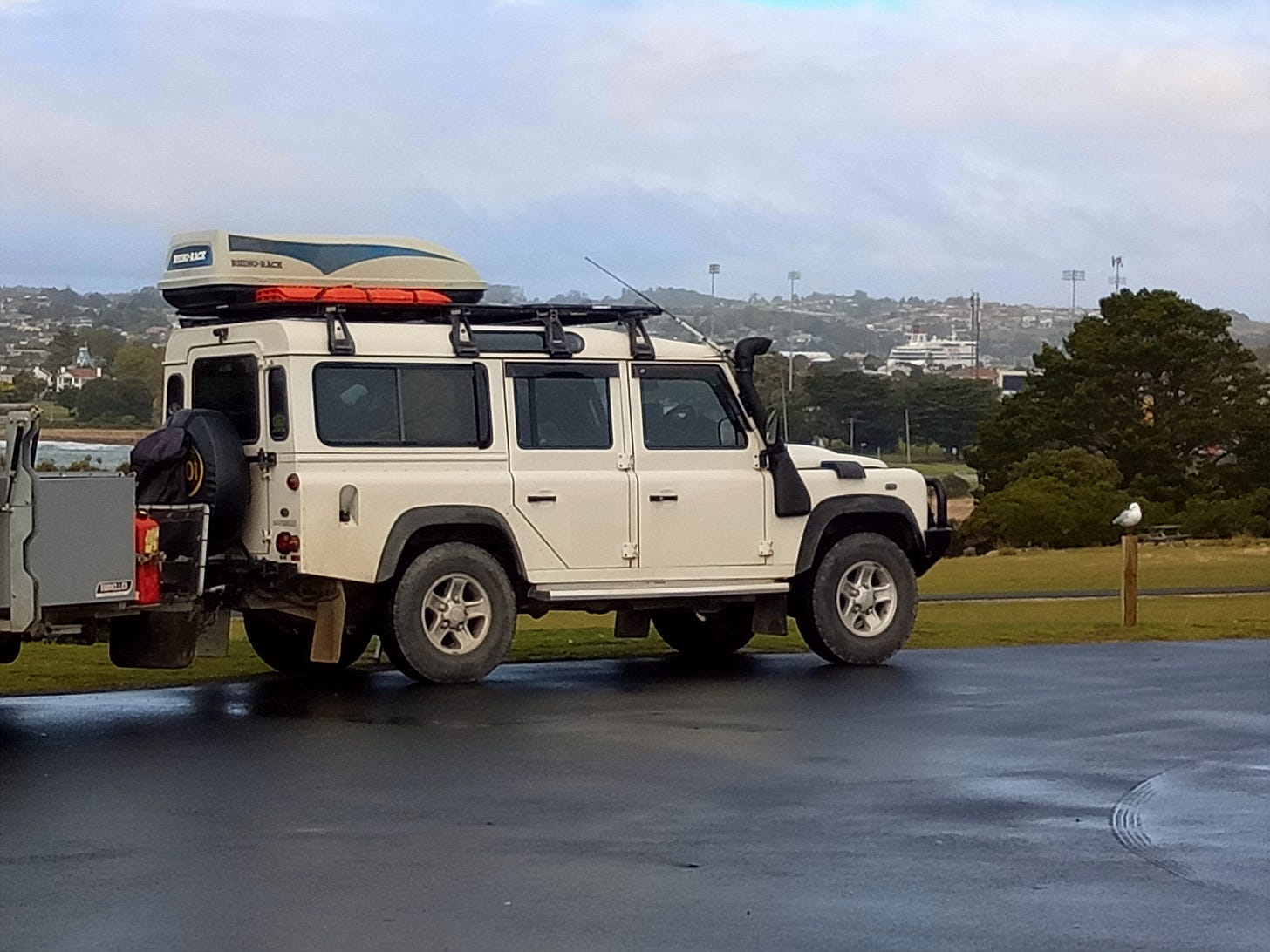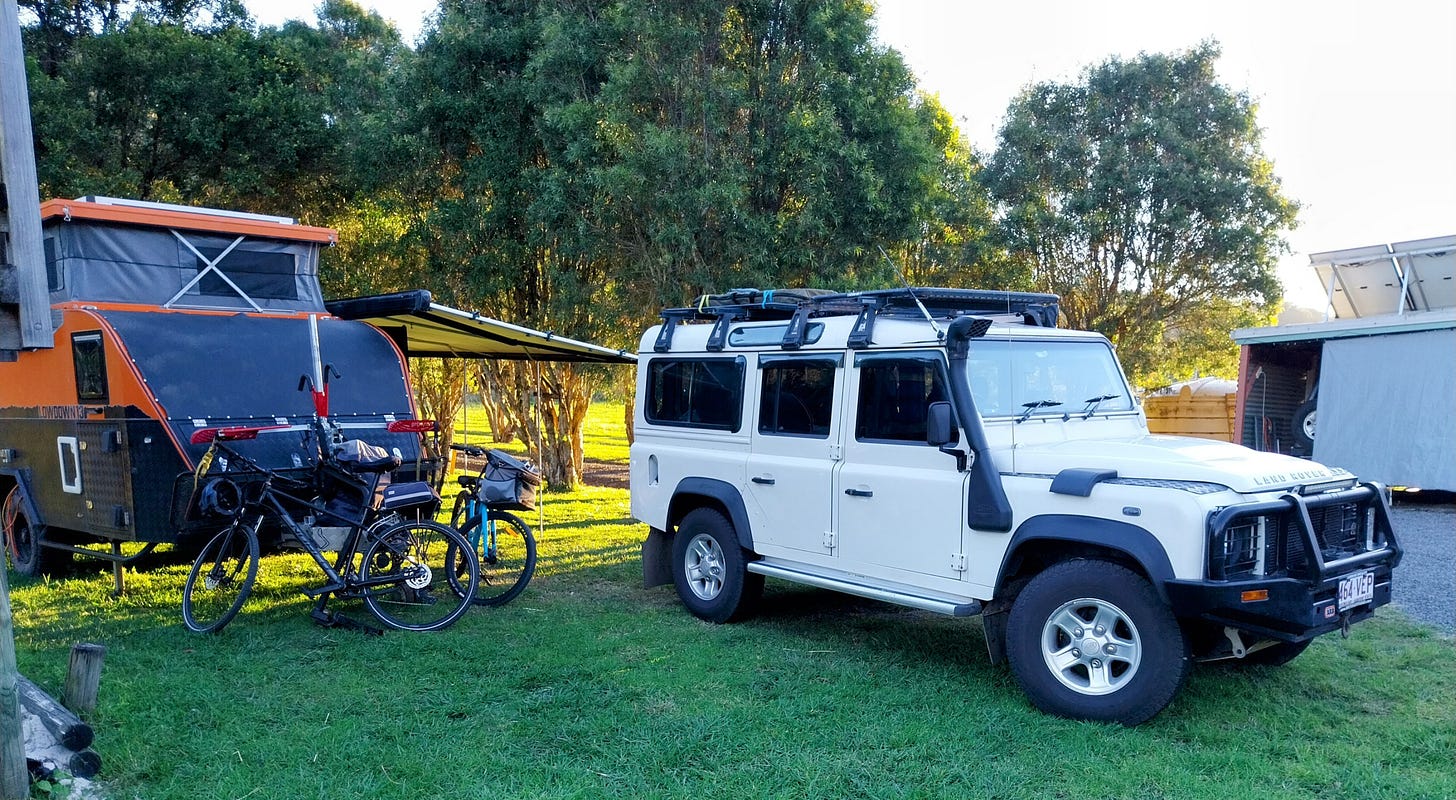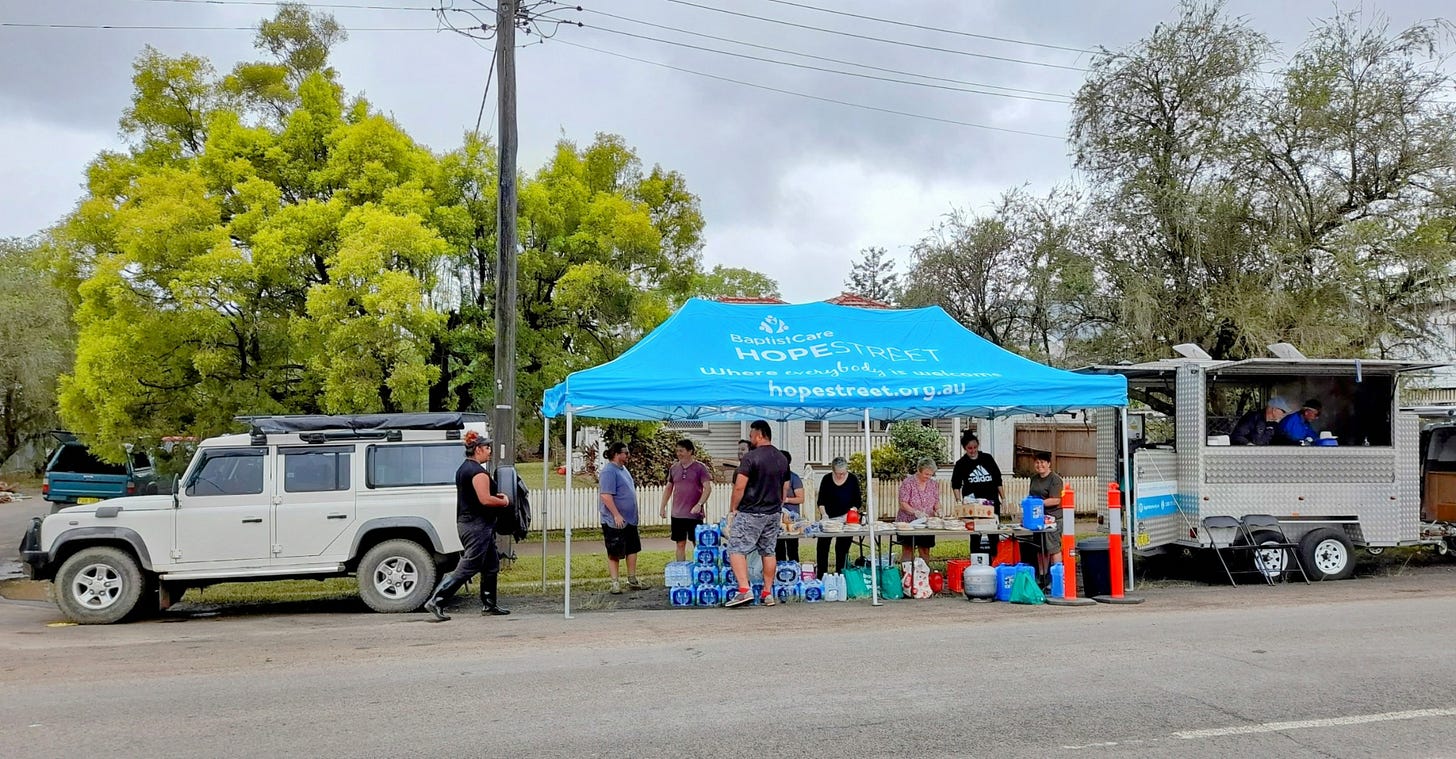Defender and Jawa caravan.
Love exploring curious things? Become a paid subscriber to Michael’s Curious World (MCW) for the cost of a coffee a month to receive exclusive posts and full access to the archive of interesting past writings, including my ‘Newbies Guide to Substack’, and support this curious journey.
SOMETHING different this time. We are now travelling full-time in our Land Rover Defender, towing our Jawa caravan, so what is involved is hitting the road indefinitely?
I’ve had a lot of inquiries about this question, so I have expanded and updated something I wrote previously to reflect more current information. I hope you find it helpful.
Last year we spent 302 days on the road travelling in Australia, including two months in Tasmania, then had a break at home over Christmas before hitting the road again.
The most obvious requirement for full-time travel is a reliable vehicle. This could be almost any vehicle, if it is well-maintained. I have seen stories about people travelling the world in small cars, like the couple who drove from Paris to Bangkok in a Peugeot 204, which can’t have been fun. I once owned a Mini, but I wouldn’t sleep in it.
Choices include if the travellers are based in the vehicle or the vehicle is used to tow a caravan or camper trailer. While 4WDs are the traditional vehicle of long-distance choice, other increasingly popular option are vans and small buses. VanLife is a big deal now. Vans range from basic to luxurious. Some just chuck a bed, portable stove and bags in the back while others have fully-equipped interiors with huge solar-power and battery systems rivalling those of the best-equipped caravans.
There are pros and cons for each vehicle choice. Those towing can leave their caravans parked and drive around, but those in vans have to move every time they want to go shopping. The most luxurious vans such as the Mercedes Sprinter can cost $200,000 and be more expensive than caravans. Those towing can focus their spending on their caravans, reducing the need to upgrade their vehicles.
Where you want to travel? If you stick to sealed roads, you don’t need a heavy-duty 4WD, but if corrugated Outback roads are your fancy, then the vehicle must be able to cope.
Thorough maintenance becomes even more essential when your vehicle is your home and you don’t want it to break down in remote places, causing great inconvenience and cost to be towed to a repair centre. Premium membership of a motoring organisation is an essential expense for full-time travel. Having to be towed once could cost far more than an annual membership.
Before hitting the road, think about your mental attitude. Can you cope with constantly moving, or do you feel uncomfortable or threatened by change? Are you a home-body or a nomad? Do you like the idea of regularly changing your view, of waking up and thinking, ‘I’m bored here, let’s move’, or do you need the reassurance of stability? Some hit the road with great enthusiasm, but soon miss family and friends and head home, while others love the freedom, indulge their curiosity and embrace constant change.
Some sell their houses, bank the profit and head for the wide open spaces, with no fixed plan to return. This works fine as long as no disasters strike, but illness and old age can become a problem. Others hedge their bets, keeping their houses, maybe renting them out for extra income, so they remain in the housing market and have a fallback option. We are in this category.
I wrote about the ‘New Nomads’, discussing how so many people are now travelling full-time (see link below) so I won’t repeat everything from that report. Please read it.
The new nomads
Become a paid subscriber to Michael’s Curious world so we can investigate things which make us curious, including history, places, people and animals. Interesting, surprising, fun.
One question which comes up regularly is how much does it cost? This is one of those ‘how long is a piece of string’ questions, because the cost is what you make it. If you hit the flash restaurants your budget will balloon, but if you can survive on pasta and coffee, you won’t spend much. Some people buy a tank of fuel every Monday, move somewhere, and spend the week exploring. We aim for about $1000 a week.
We have chosen a classic Land Rover Defender to tow a compact hybrid caravan. Land Rovers, which later became Defenders, are the vehicle of choice for many long-distance overlanders because they are tough, economical, roomy and simple to modify and fix.
Defender in Devonport, with the Spirit of Tasmania ferry in the background.
Land Rovers have a long history in Australia, which is both the world’s largest island and smallest continent, so the distances are vast and city cars just don’t last in the Outback. Landys were simple, robust and easy to fix far from a car dealer.
About 900 series Land Rovers were imported from 1950 for the construction of the Snowy Mountains hydro-electricity scheme, often abused in extreme conditions. The first Toyota didn’t arrive until 1956, and it didn’t even have a low-range gearbox.
Explorer Len Beadell bashed series Landys through the bush opening up several new interior roads, including the Connie Sue Highway, across the centre. His books make great reading. The Land Rover history is certainly there.
I’m not a mechanic, so I like to be fussy about getting the vehicle maintained by people who know what they are doing, which greatly reduces the chances of breaking down in the middle of nowhere. Mind you, it doesn’t always work. Any vehicle can break down anywhere.
Our particular Defender, known in the family as ‘the big white box’, is a 2009 model, so not really that old, and production of the classics ended in 2016. Despite having done 240,000 kilometres it is still worth more than what we paid for it, according to what people are asking on carsales.com.au.
I recently saw one bloke asking $95,000 for an admittedly pristine Defender, one of the last classics made, which is remarkable as they only cost about $55,000 new in Australia. Selfishly, I hope he gets it, to keep up the value of ours.
We added a Gripsport two-bike rack to the caravan drawbar.
Our Defender has been through the full range of conditions, from way up north to Cape York and the tropical Gulf, west into the 40-degree desert of Outback Queensland (see our Dinosaur series in the menu for this newsletter), south to Tasmania as far down as it is possible to drive and was in a minus five snowstorm in the Snowy Mountains close to Australia’s highest point of Mt Kosciuszko (2228 metres).
Support vehicle for the Lismore Baptist Church food van which fed thousands of people whose houses had been flooded.
It was even used as an emergency food van support vehicle during Lismore’s disastrous 2022 floods.
A true workhorse
It is a true workhorse, lacking any carpet, with hard plastic surfaces, upright seating and a roomy box-like aluminium body bolted to a massive steel chassis.
The engine in ours is a 2.4 litre Ford Puma turbo four-cylinder diesel mated to a six-speed manual gearbox, which is slow but strong, more like a van than a car.
That’s not surprising as the engine and gearbox are from the Ford Transit van and there are millions of Transits being flogged to death around the world, so they are durable, if maintained.
Low range has a really low first gear and having six low gears gives a huge range of speed options in difficult conditions.
Is it reliable, you ask, being a Land Rover? Well, it’s not bad, although not perfect. An oil seal did fail on the transfer case, which lost the oil, frying the gears, which had to be rebuilt. Could happen on any vehicle.
And it has recently had the fuel injectors replaced after one started leaking into a cylinder. Again, could happen to any vehicle, as fuel injectors are generic parts made by supplier companies and fitted to many models.
The brakes have recently had a major overhaul, including replacing a leaking master cylinder. Brake overhauls are just basic maintenance for any vehicle, particularly one which tows a caravan on expeditions.
But we have never failed to get home, and my wife says she feels she can trust the vehicle, so that’s a big plus. Happy wife=happy life, as they say.
Maintenance is straight-forward on such a simple vehicle and any mechanic who refuses to work on one should get another job.
Keep reading with a 7-day free trial
Subscribe to MICHAEL'S CURIOUS WORLD to keep reading this post and get 7 days of free access to the full post archives.

